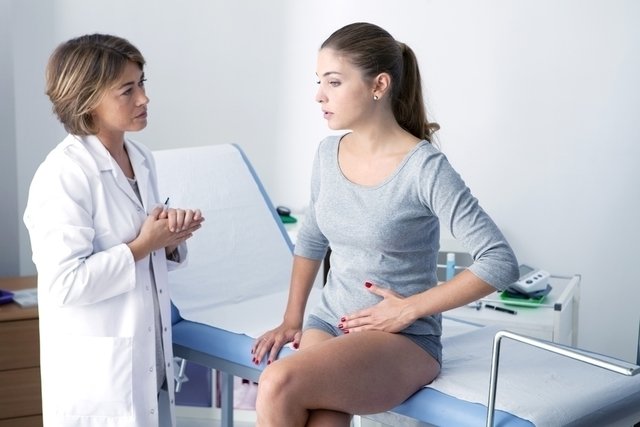A uterine polyp is the abnormal growth of endometrial cells, which leads to the formation of a nodule that can cause symptoms such as vaginal bleeding outside of menstruation, heavy menstrual flow, abdominal pain and/or difficulty getting pregnant in some cases.
Although the exact cause of uterine polyps, also called endometrial polyps, is not known, it is known that it is more common in menopausal women with hypertension and/or who use tamoxifen.
If you suspect a uterine polyp, it is recommended to consult a gynecologist. Although treatment is not always necessary, the doctor may recommend removing the polyp through surgery in some cases.

Uterine polyp symptoms
The main symptoms of uterine polyps are:
- Intense menstrual flow;
- Vaginal bleeding outside the menstrual period, after intimate contact or during menopause;
- Strong cramps during menstruation;
- Abdominal pain;
- Difficulty getting pregnant.
However, polyps in the uterus normally do not cause any type of symptoms, and are common to be identified during routine examinations recommended by the gynecologist.
Can uterine polyps interfere with pregnancy?
Uterine polyps can make it difficult for some women to implant a fertilized egg in the uterus, reducing the chances of pregnancy.
Furthermore, depending on the size and number of polyps in the uterus, there may also be a greater risk of miscarriage, although more studies are needed to prove this risk.
How to confirm the diagnosis
The diagnosis of a uterine polyp is made by a gynecologist based on the symptoms presented, the person’s health history and the results of tests, such as transvaginal ultrasound, sonohysterography or hysteroscopy, which allow the polyp to be identified in the uterus.
If you want to make an appointment, you can find the gynecologist closest to you using the tool below:
Taking care of your health has never been easier!
In addition, the doctor may also recommend endometrial biopsy, curettage or removal of the polyp by hysteroscopy so that a sample of uterine tissue can be analyzed in the laboratory and rule out the possibility of uterine cancer.
Possible causes
Uterine polyps are caused by the abnormal multiplication of endometrial cells, which causes this layer that lines the uterus to grow into the uterus. However, the exact cause behind this growth is not known.
Furthermore, polyps in the uterus are more common in perimenopausal or menopausal women with hypertension, obesity and/or polycystic ovary syndrome and who use tamoxifen or undergo hormone replacement therapy with high doses of estrogen.
How the treatment is carried out
In most cases, uterine polyps do not require treatment and the gynecologist can only recommend regular monitoring using ultrasound to check whether the polyp has increased or decreased in size.
However, if there are symptoms, such as vaginal bleeding or infertility, or a high risk of developing uterine cancer, the doctor may recommend removing the polyp through surgery or even removing the uterus in some cases.
Read too: Uterine polyp surgery: how it is done and recovery
Sometimes, after removing the polyp in the uterus, the use of an IUD with levonorgestrel may also be indicated to reduce the risk of the polyp returning. Check out what a levonorgestrel IUD is and how it works.
Can a uterine polyp turn into cancer?
Most uterine polyps are benign lesions that rarely turn into cancer, but this can happen in some cases, especially in menopausal women and women over 60 who have large polyps and/or have symptoms.
Therefore, regular surveillance and correct treatment of polyps with a gynecologist is essential.
Bibliography
- CARBONNEL, Marie et al. Uterine factors in recurrent pregnancy losses. Fertility and Sterility. Vol.115, n.3. 538–545, 2021
- STATPªEARLS. Endometrial Polyp. 2023. Available at: <https://www.ncbi.nlm.nih.gov/books/NBK557824/>. Accessed on January 23, 2024
- RAZ, Nili et al. Endometrial polyps: diagnosis and treatment options – a review of literature. Minim Invasive Ther Allied Technol. Vol.30, n.5. 278-287, 2021
- LUDWIN, A.; et al. Removal of uterine polyps: clinical management and surgical approach. Climacteric. 23. 4; 388-396, 2020
- CLARK, T. J.; STEVENSON, H. Endometrial Polyps and Abnormal Uterine Bleeding (AUB-P): What is the relationship, how are they diagnosed and how are they treated?. Best Pract Res Clin Obstet Gynaecol. 40. 89-104, 2017
- VITALE, SG; et al. Endometrial polyps. An evidence-based diagnosis and management guide. Eur J Obstet Gynecol Reprod Biol. 260. 70-77, 2021
- MANSOUR, T.; CHOWDHURY, Y. S. IN: STATPEARLS (INTERNET). TREASURE ISLAND (FL): STATPEARLS PUBLISHING. Endometrial Polyp. 2022. Available at: <https://www.ncbi.nlm.nih.gov/books/NBK557824/>. Accessed on October 18, 2022
- NIJKANG, Njume Peter; et al. Endometrial polyps: Pathogenesis, sequelae and treatment. SAGE Open Medicine. 7. 1-12, 2019
- MUNRO, Malcolm G. Uterine polyps, adenomyosis, leiomyomas, and endometrial receptivity. Fertility and Sterility. 111. 4; 629-640, 2019
- CLARK, T. Justin; et al. Endometrial Polyps and Abnormal Uterine Bleeding (AUB-P): What is the relationship, how are they diagnosed and how are they treated?. Best Practice & Research Clinical Obstetrics & Gynaecology. 40. 89-104, 2017

Sign up for our newsletter and stay up to date with exclusive news
that can transform your routine!
Warning: Undefined array key "title" in /home/storelat/public_html/wp-content/plugins/link-whisper-premium/templates/frontend/related-posts.php on line 12
Warning: Undefined array key "title_tag" in /home/storelat/public_html/wp-content/plugins/link-whisper-premium/templates/frontend/related-posts.php on line 13




